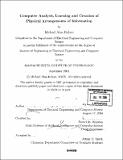Computer analysis, learning and creation of physical arrangements of information
Author(s)
Kahan, Michael Alan
DownloadFull printable version (4.738Mb)
Other Contributors
Massachusetts Institute of Technology. Dept. of Electrical Engineering and Computer Science.
Advisor
Patrick H. Winston.
Terms of use
Metadata
Show full item recordAbstract
Humans' ability to arrange the individual pieces of a set of information is paramount to their understanding of the set as a whole. The physical arrangement of pieces of information yields important clues as to how those pieces are related. This thesis focuses on computer analysis of physical arrangements and use of perceived physical relations, such as horizontal and vertical alignment, in determining which pieces of information are most likely related. The computer program described in this thesis demonstrates that once a computer can deduce physical relations between pieces of information, it can learn to order the information as a human would with great accuracy. The information analysis methods presented in this thesis are of benefit to projects that deal with user collaboration and the sorting of data based on relative importance, such as the Electronic Card Wall (EWall) project.
Description
Thesis (M. Eng.)--Massachusetts Institute of Technology, Dept. of Electrical Engineering and Computer Science, 2004. Includes bibliographical references (leaves 75-76).
Date issued
2004Department
Massachusetts Institute of Technology. Department of Electrical Engineering and Computer SciencePublisher
Massachusetts Institute of Technology
Keywords
Electrical Engineering and Computer Science.